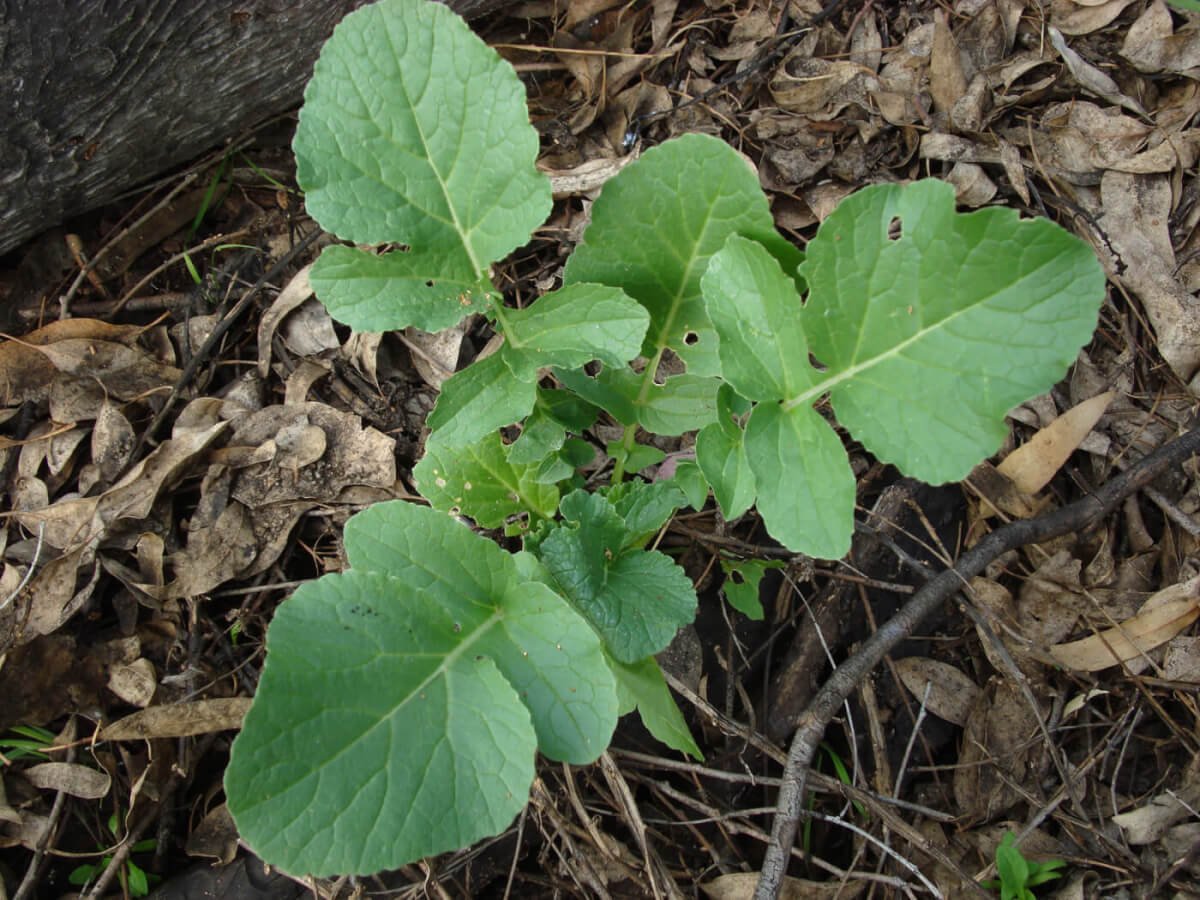When encountering a field of wild radishes in the springtime with a self-reliance class, I quickly see that the group doesn’t recognize the plants around them. To give them a hint, I’ll first crush a bit of the stem and let them smell it. “Oh, that’s very familiar” most of them will say. Then I will pull up a root, which is a long carrot-like white taproot. It’s very woody, but the skin can be readily peeled off. I give each one a piece of this root, and let them smell again. The odor of the root is much more pungent and unmistakable. I encourage them to taste a bit. “Tastes like radish,” most will say. Yes, indeed! It smells and tastes like radish because that’s what it is. For most people, the root of the wild radish bears little resemblance to the little round red things purchased in supermarkets.
Because the root of a wild radish is so woody, it really isn’t all that useful for food, unless you want to take the time to peel each root and use just the skin. Occasionally, during wet winters and in very rich soil, the radish plant will produce a root that is much less woody and more-or-less edible raw in salad (but it will be spicy), especially if you slice it up. Normally, however, you won’t be eating the wild radish root, because every part of the wild radish plant can be eaten instead. And each part has a different texture and flavor which lends it to different recipes.
“The leaves can be added to soups, egg dishes and stews, used in pretty much the same way you’d use spinach greens.”
Recognizing the Wild Radish
Each young leaf of wild radish is lyrately pinnately divided, meaning that there is one large end lobe and smaller side lobes or segments to the leaf: It resembles a guitar. When the young leaves of wild radish are newly emerging, it would be easy to confuse the leaves with those of mustard (Brassica species). However, wild radish leaf lacks the fine hairs that you find on mustard. If you examine a wild radish leaf closely, it will be covered somewhat sparsely with bristles, but the leaf is smoother than mustard, and you will see a tinge of red in the midrib of the radish leaf.

a white taproot; it is largely woody and most inedible, save for the soft outer layer.
As the plant flowers, instead of the usual yellow mustard flowers, the flowers will be lavender, white, or a pale yellow. There is the typical mustard family flower formula of 4 petals, 4 sepals, 6 stamens (4 long and 2 short), and 1 pistil. The flowers are followed by fleshy seedpods that resemble pointed jalapeño peppers.
The root of wild radish is a white taproot, not at all like the radish you might grow in your garden or buy in the store. It is largely woody and inedible, though there is a soft outer layer that can be peeled off. The taste of this outer root layer is so obviously “radish” that most anyone can identify this plant by that aroma and flavor.

leaf and stem. Each young leaf is lyrately pinnately divided, meaning that there is one
large end lobe and smaller side lobes or segments to the leaf.
Overall, wild radish can get up to 4 and 5 feet in ideal conditions. You will find them in fields, wet bottom lands, farms, vacant lots, and disturbed soils. Eating Wild Radish The leaves can be collected at any time in their growing cycle, cut into small pieces, and added to salads. They are hot and spicy, so add to other greens. Though they are good in salads, you’d probably not care for a salad of only radish leaves. Mix them with other greens, and toss in some tomatoes and avocado.
The leaves can also be added to soups, egg dishes, and stews, used in pretty much the same way you’d use spinach greens. The white-to-lavender flowers are quite tasty and sweet when you first pick and nibble them, but your mouth will get very hot. Eat them sparingly. You can pick the flowers and add to salads and other dishes as a tasty garnish. The tender flower tips which includes the tender stems—somewhat resembling Chinese broccoli—can be snapped free, steamed or boiled, and served with butter, cheese, or a spicy sauce. You’d serve this very much like asparagus, except they are much spicier. The green seedpods, which somewhat resemble jalapeño or serrano peppers, can be nibbled when they are still tender inside and haven’t gotten woody. You can add the chopped tender pods to soups and salads or try pickling them. Once they get old, and white inside, they are already too old to eat and should be left alone to produce seed.
Health Benefits
According to medical consultant Anthony William, radishes are antibacterial, anti-fungal, and a diuretic. They are rich in Vitamin C, folic acid, and anthocyanin and are excellent for sinus congestion, sore throats, chest colds, asthma, and hoarseness. Radish is also very helpful in preventing and fighting urinary tract and bladder infections. Eating radishes (wild or otherwise) on a regular basis can help prevent colds and flus and they are a great anti-cancer food and are known to specifically benefit stomach, kidney, mouth, and colon cancer.
It’s also a good idea to eat radishes with starchy foods such as pasta, potatoes, and grains as they have enzymes that aid in the secretion of digestive juices. Radish leaves contain more vitamin C, protein, and calcium than the root.
The green tops are highly nutritious and mineral rich and should be valued as much if not more than their roots. Radishes and their greens can be juiced for an excellent detoxifying drink that can soothe the digestive tract and cleanse the entire body.


